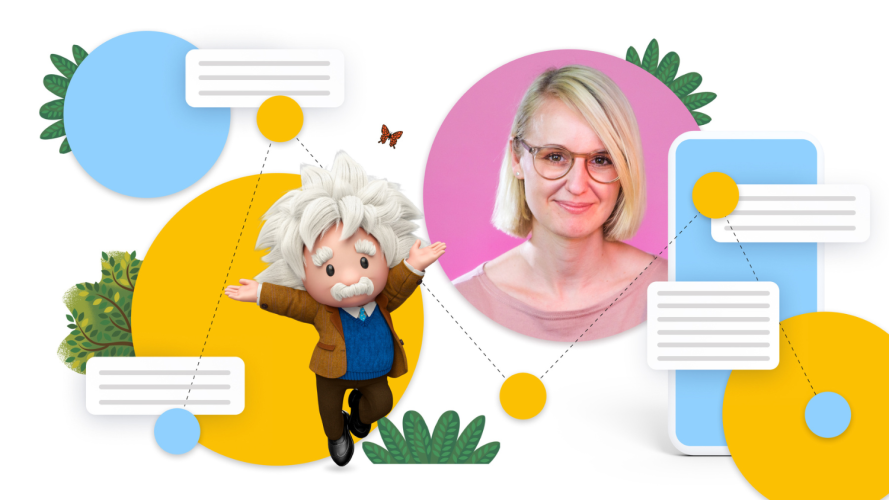3 Ways Generative AI Will Help Marketers Connect With Customers
3 min read




To create a great Salesforce solution, you need to understand users and their contexts. But, this discovery stage often suffers budget and time constraints that can put a project at risk. This is where generative AI opens up countless possibilities to streamline and accelerate the strategic design process. Now, challenge framing and project scoping don’t have to be a luxury.
First, let’s consider what’s remarkable about generative AI: It fundamentally changes the way users interact with machines. Instead of giving direct commands, we now express our desired outcomes through prompts when using these new AI platforms. While we’re all still learning about prompt engineering, designers are well-suited to pick up the concepts quickly.
Designers are ready for AI-driven discovery, because we naturally focus on broader business objectives. We don’t let immediate steps bog us down. Crafting a meaningful output involves skillfully framing the prompt, providing enough context, offering benchmarking examples, specifying the desired tone, and iterating with different variations.
Does this sound familiar? Well, it’s a common challenge in our project work, just on a smaller scale. While there are copious tips on crafting perfect email notifications, we shouldn’t forget the immense potential of AI to address more significant challenges.
Generative AI allows us to deliver meaningful inputs much faster. Now, let’s explore five design practices where using AI can lead to substantial benefits:
Personas, fictional yet data-backed representations of specific user types, are vital to enabling businesses to target audiences and offer personalized experiences. Gone are the days of spending weeks crafting these personas manually. With AI for UX design, we can swiftly collect and analyze vast amounts of data, pinpointing behavioral patterns that lend greater accuracy to the personas. Armed with such insights, AI can even offer invaluable assistance in generating novel ideas that might have eluded us otherwise. And to top it off, completing persona profiles with detailed descriptions and unique AI-generated photos has become possible.
Understanding the customer journey is crucial for grasping their needs and goals. It’s how we pinpoint areas where we can enhance their experience. Though AI may generate somewhat generic outcomes, it does serve as a valuable starting point. We can get a sample journey that’s specific to an industry or use case. From there, we can fine-tune it using our own expertise and insights.
The Jobs to Be Done framework is a potent tool that helps us uncover the outcomes customer desire. This is a fundamental aspect for developing a successful, customer-centric product. AI isn’t a substitute for quality user research, which yields key insights for the Jobs to Be Done approach. But it can help suggest questions and craft statements per the JTBD framework. To take it up a level, generative AI also saves us a ton of time when collaborating with business analysts. Instead of spending hours analyzing each Job to Be Done and translating details into user stories with the right acceptance criteria, we can use AI for UX design to get a head start. Then, all we have to do is fine-tune the results.

3 min read

6 min read
UX metrics serve as quantitative measurements that provide an objective evaluation of user experience. AI is fully capable of suggesting appropriate metrics based on the specific use case and offering approaches for their ongoing tracking. Whether you’re focusing on load times, conversion rates, error rates, or usability, having a virtual AI buddy to bounce off ideas can be helpful. And while certain metrics may not match the Salesforce context just yet, AI also offers valuable general guidance and industry benchmarks to consider when analyzing data. This proves incredibly useful in demonstrating the real impact of design efforts on business objectives.
User research is a fundamental practice that forms the basis of most other design techniques. Without taking the time to understand our users, we cannot effectively produce any user-centric deliverables. Several existing tools that support AI for UX design provide automated research and usability testing solutions. However, design experts concur there are limitations that affect the consistency and reliability of AI-generated results. Nonetheless, AI can support designers in their work by suggesting research approaches, formulating questions, generating transcripts, and analyzing quantitative data to uncover trends.
Generative AI is a powerful tool with the potential to revolutionize UX design. By automating many manual tasks, AI not only assists designers but also benefits other roles in the ecosystem, leading to faster and more effective creation of user-centric experiences.
However, not all AI platforms are equal. It’s important to pay attention to data security when using third-party applications. Consultants should always follow their AI compliance policies. Trailblazers who work with clients should consider all implications before they embark on the generative AI journey. Some platforms, such as Einstein GPT with the Trust Layer, are designed with privacy and security in mind. This means that they don’t store or retain the training data for these models, which helps to protect the privacy of users.
As the technology continues to advance, it’s crucial to maintain a human connection. Ultimately, we’re crafting experiences for fellow human beings, not machines.

Get the latest articles in your inbox.


